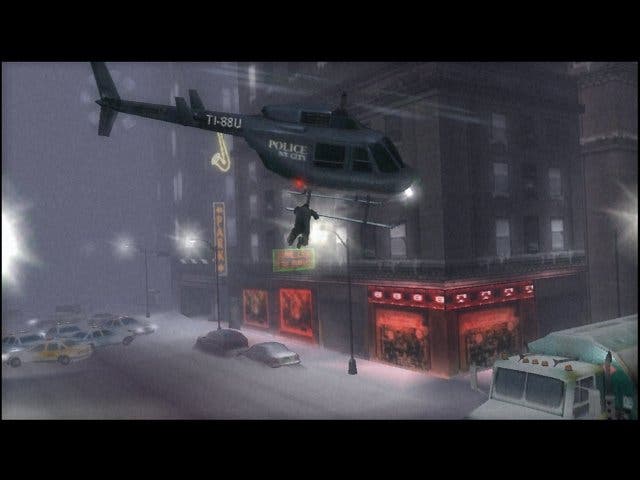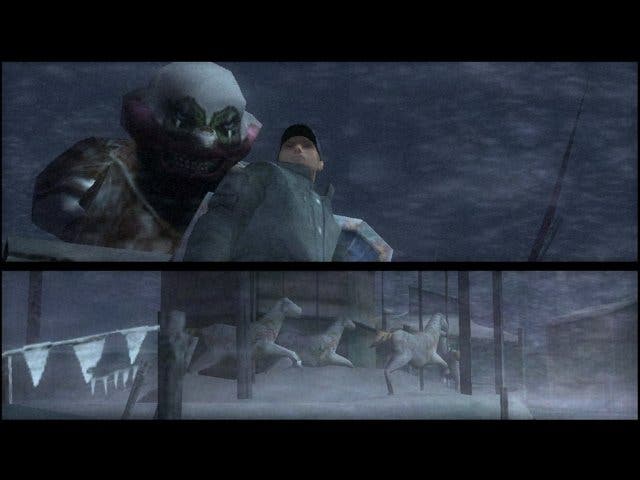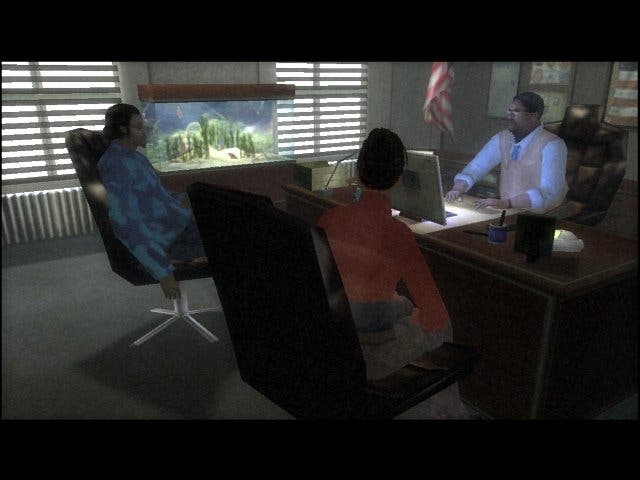Fahrenheit
For Kristan, it's Fahrenaway the best adventure game of modern times.
It says a lot about the nature of the games business that a game as exciting as Fahrenheit can be left hung out to dry by its publisher. Less than a year into the game's development, Quantic Dream was left contemplating its options once it became clear that its publisher Vivendi-Universal Games was no longer interested in releasing it. With the personnel that originally signed the game for VUG having left the organisation, those left in charge seemingly had no clear understanding of where the project was heading or its commercial value.
As Quantic Dream boss David Cage recounted in a recent interview with Eurogamer, "We had no one to talk to and we suddenly felt a little bit lonely without any kind of support. It quickly became obvious that no one in the new American staff had any time to spend trying to understand this strange new idea."
Stop me if you've heard this one before
It's a familiar tale, but thankfully one with a happy ending - which has seen the game not only rescued from the scrapheap by fellow Frenchmen Atari, but given extra funding to turn it into a title genuinely worth sitting up and taking notice of. To reflect that Fahrenheit may have ended up suffering the same fate as Sam & Max: Freelance Police is enough to make a shy, bald Buddhist reflect and plan a mass murder. But we'll leave that to the Smiths fans to contemplate. We've got adventuring to do.
The most memorable games down the years have always crammed some of their best moments into the opening sequence, and the same holds true for Fahrenheit. Holed up in a beaten up New York diner, IT maintenance man Lucas Kane finds himself with a little more on his plate than the half-eaten steak and chips he couldn't quite finish off. Possessed by unseen forces, he takes himself off to the men's room and carves strange symbols into his wrists before committing a brutal, clinical murder on an innocent fellow customer.
Awakening from his trance you take control of Kane's actions, choosing whether to try and hide the evidence, mop the blood up, wash your hands, pay your bill and leave through the front door, acting like nothing's happened, or just getting the hell out through the back door as quickly as you can. Or a combination of the two. The permutations in the opening scene alone make the game not only intriguing to play, but just as fun to watch how someone else does it. It says as much about the kind of person you are as your grounding in the adventure gaming lineage.
The things I miss

The most exciting thing, initially, is how your actions immediately have an impact on the course of the investigation. Somewhat uniquely, you're not just playing the hackneyed fugitive-on-the-run-from-the-law, but the people on his tail. In this case you also take control of two NYPD crime scene investigators Carla Valenti and her partner in crime (solving) Tyler Miles, and both will spot things that the other character misses, so picking up on vital clues can make a discernable difference some way down the line.
A few chapters down the line you're already making choices with Kane which may - or may not - affect how things dovetail later on. They may not seem especially significant at the time, but hours later, it's heartening to learn that even seemingly minor decisions have a bearing on the investigation. For example: did the cop see you in the diner or the park? Did you sit back down in your seat in the diner? Do you lie to your brother about what's happened? It's a game that's always asking you questions; very much like a modern-day 'choose your own adventure' book that you get to play.
There are a ton of bad decisions to make, and sure enough you'll make them, if only out of curiosity to find out what happens. But with a sensible checkpointing system, you're rarely forced to retread old ground for more than couple of minutes, and with around 50 scenes in the game to play through few of them outstay their welcome.
Out of control

Although we don't want to dwell for too long on tedious camera and control issues, it'd be neglectful in the extreme not to highlight them. It's one area of the game design we were never 100 per cent comfortable with and occasionally contributes to a few grumbles along the way. Although movement is mapped to the left stick, the direction you steer the character with is relative to the camera angle, and not always as intuitive as you might think. For example, if the camera angle suddenly switches so you're running into the screen, it doesn't always follow that pressing the direction you were holding down a second ago will be the correct one anymore (have they been taking tips from Capcom?). With your character often sent lurching off in the wrong direction, it's not always helpful to then have to reposition the camera manually with the two shoulder buttons. Why Quantic Dreams couldn't have just stuck with the tried and trusted two-stick method is a moot point. Luckily, the game doesn't rely heavily on precision movements, so it's only a niggle, but one that could have so easily been solved.
The now-vacant right stick tends to be used to carry out context specific actions, such as climbing, drinking, picking up objects or selecting a conversation choice. Rather than bog the player down with entire sentences, Fahrenheit opts for one-word choices like 'lie' or 'truth', or subject-specific keywords. We can see the benefits of having four selectable icons/keywords mapped to the right stick, but it's fair to say it comes at a price that wasn't really worth paying. Making the game as slick to control as possible should have been a priority.
When Fahrenheit's not tasking you with playing detective, or engaging the player with conversation choices, there's a fair bit of action to engage in. Once you're passed the halfway point, the action quotient really ramps up; but never in a way that you'd traditionally associate with an action game.
Reaction test

In the tutorial (starring the game's creator himself, David Cage, replete with attractive Bobby Charlton-style comb-over, no less) you're given small glimpse of what's to come as a car comes tearing towards you at high speed. Presented with two icons in the centre of the screen, each one represents the four directions of the two analogue sticks with a different colour. As one or both icons light up, you're given around a second to press the sticks in the required direction, allowing the game's animators to concoct a variety of increasingly furious challenges which really test your co-ordination skills when the going gets tough. It's a slightly odd way of replicating your actions, but it'll be familiar to anyone who's played Shenmue at least.
On top of that, these action sequences are also supplemented by the need to hammer the shoulder buttons left and right, like some sort of modern day Track & Field. Although these sections are pretty straightforward, modern joypads really aren't up to the job, and we're quite sure many players will feel slightly exasperated why they're sat there with their joypad wedged upside down between their knees hammering analogue triggers. At the very least you'll sport an amusing facial expression while you're doing it.
It's during these frantic and demanding action sequences that you begin to question why Cage and co. felt the need to pander to the needs of action-oriented gamers with these exceptionally basic interludes. At the very least they're at odds with the sophistication of what the game's trying to achieve, although they do allow the artists and animators the chance to set up some dramatic and well put together scenes that would have otherwise been passive animations. Trying to marry such an odd fit is hard to reconcile when all you want is more of the intrigue and atmosphere that oozes out of the game's best sections.
Simple Simon

On the one hand the pacing of the game might be a little one-dimensional if you're embroiled with heavy dialogue and puzzle-solving, but on the other hand it's hard to understand exactly what sort of gamer would want to play Simon Says and Track & Field more than is strictly necessary. Adventure gamers will roll their eyes at it, and action gamers will see it as too simplistic. It's an odd decision.
The saving grace, thankfully, is what's going on the screen. As a means to an end, it's well worth becoming a twitching mass of button-mashing flesh whenever the game wants you do. It's an odd Pavlovian response, but when the "Get Ready" message flashes up, there's palm-sweating excitement in store - and it's all on you. Really, the key is not to stress too hard over "why am I engaging in these bizarre little action rituals?" and realise that the story is the star, and advancing it becomes you're raison d'être for the duration you'll be playing it.
It's an odd thing to have to mull over, but the narrative really is a cut above practically anything else we've seen in ages. You'd probably do headstands and breakdance if it got you to the next chapter. So what is so compelling about the narrative? For a start, the game sucks you into a paranormal murder mystery right from the beginning. From the opening scene you're wondering what the hell's just come over him and feel just as keen to discover the answers as Kane is. Taking up the role of investigator as well is a superb idea that makes you understand that you're actually both trying to find out the same thing.
Plot holing

Just as crucial is the overall direction of the project; the acting style is measured and understated, the characters are easy to identify and empathise with, and the dialogue is almost always on the money. Apart from a few questionable sequences near the end and some plot holes that we won't spoil, it's a cut above practically anything else we're used to. Fair enough, it's still nowhere near cinematic quality, but if videogaming carries on heading in this direction it won't be long before we start demanding classy performances every single time.
Inevitably, though, Fahrenheit is going to come under intense scrutiny from those looking to pick holes over whether the plot really is a rubber band that stretches to fit the actions of the player. To that, we'd have to accept that it's not perhaps as significant as it initially appeared to be, but that the subtle choices you make always seems to crop up when you least expect them to. They may not change the overall story arc (for that would prove to be a vastly ambitious undertaking), but they do make a difference to specific parts of the scenes later on - and that in itself is a gratifying advancement with huge potential.
Moving the discussion of Fahrenheit to a more aesthetic level, it's worth praising the wonderful motion capture techniques in the game, too. Allied with an excellent artistic vision, the fluidity of the actors makes even the most incidental motions possible - and watching the unlockable movie of the making of is a real eye-opener to how far Quantic Dreams were prepared to go in order to make the game look as convincing as possible. With excellent lip-synching, facial detail and a range of expressions, there has rarely been a game that has delivered consistently credible scenes in the manner that Fahrenheit does. That it does so with a 24-style use of multiple picture-in-picture windows merely adds to slickness of what you're experiencing.
Bad Angel

A special mention, too, for Cage's decision to hire the Angelo Badalamenti to score the music. Atari gave the green light to the extra expenditure required to secure his services, and it was worth every penny for adding a haunting, desperate texture to the package. You'd miss it if it wasn't there; put it that way. In sonic terms, the game serves as a shining example to its peers of why it's so important to hire good voice actors and a renowned composer. It's that good.
Inevitably we have to untangle this web of positives and negatives to grope for a bite-sized conclusion. But as hard as we try it's another one of those impossible-to-score games where the number at the end is practically meaningless.
Some will look at the game and insist it's flawed in several crucial areas and mark it down accordingly, while others will bask in the rosy glow of its innovations. The question we had to ask ourselves wasn't so much whether we thought the mechanics made the game good or bad, or whether we agree with QD's implementation of the action sequences, or even if we think the game really does give the degree of choice that Cage suggested it did.
Head heart dichotomy
Broken down to its base elements it's clear that Fahrenheit is by no means perfect. The control system is often counter-intuitive, the camera implementation is sloppy, and the action sequences are a square peg in the midst of the lovingly-crafted round hole that is the narrative. But yet, for every little niggle anyone could justifiably come up with (and, really, there are plenty), the amount of enjoyment we gleaned from the whole experience outweighs such minor issues to extent where the only thing you can say with any accuracy is that rating such a game is ultimately a head/heart issue.
Scoring Fahrenheit with your head you'd could slap a seven on it and feel confident that it sits comfortably in that zone where it did some very cool things that didn't quite come off. But if we did that it would imply that there are many other games out there today in the genre you'll enjoy more, which is obviously complete nonsense. With that in mind we had to follow our hearts and award Fahrenheit the nine it deserves for being probably the most enjoyable, forward-looking and thoughtful piece of videogaming we've played in this or in any year. We never thought we'd say this, but it's a real step forward for the adventure game genre. Now try sticking that quote on the box.




